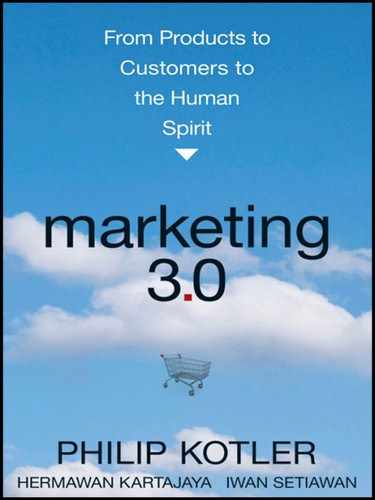CHAPTER TWO
Future Model for Marketing 3.0
THE PAST 60 YEARS OF MARKETING: A BRIEF RETROSPECT
Marketing has been one of the most exciting subjects in the business world during the past six decades. In a nutshell, marketing has revolved around three major disciplines: product management, customer management, and brand management . In fact, marketing concepts evolved from a focus on product management in the 1950s and 1960s to a focus on customer management in the 1970s and the 1980s. It then evolved further and added the discipline of brand management in the 1990s and the 2000s. The continuous adaptation of marketing concepts to different eras of human lives is what keeps it exciting.
Ever since Neil Borden coined the infamous “marketingmix” term in the 1950s and Jerome McCarthy introduced the four Ps in the 1960s, marketing concepts have undergone significant transformation while adapting to the changing environment.1 The manufacturing sector was the center of the U.S. economy in the postwar 1950s and continued to soar during the 1960s. In such an environment, it was logical to see the development of marketing concepts simply focused on the product management discipline.
Marketing was initially viewed as just one of several important functions supporting production, along with finance and human resources. The key function of marketing was to generate demand for products. McCarthy’s four Ps concisely explained the generic practices of product management in those days: develop a product , determine the price, do the promotion, and set up the place of distribution. As business was on the upswing during those two decades, nothing more was needed from marketing other than those tactical guidelines.
It all suddenly changed when the U.S. economy—and the Western economy in general—was hit by oil shock-driven stagflation in the 1970s. The economy remained uncertain throughout the 1980s because economic growth had mostly migrated to developing countries in Asia. Generating demand during these turbulent and uncertain times was harder and required more than just the four Ps. Demand was scarce. Some products were launched to compete with one another to win buyers. Over the course of these two decades, consumers became smarter buyers. In consumers’ minds, many products were seen as commodities because they had no distinct positioning. The changing environment forced marketing professionals to think harder and create better concepts.
More Ps—people, process, physical evidence, public opinion, and political power—joined the original four Ps.2 However, the classic model of Marketing 1.0 remained tactical in nature. Perhaps the downswing was a blessing in disguise, as marketing finally gained prominence during this period of low demand. To stimulate demand for products, marketing evolved from a purely tactical to a more strategic level. Marketers realized that to effectively generate demand, “customer” should replace “product” at the heart of all marketing activities. The customer management discipline, including strategies such as segmentation, targeting, and positioning (STP), was introduced. At this point, marketing was no longer only tactical. As it focused more on the customers than on the products, marketing became strategic. Since then, the development of the four Ps has always been preceded by the development of the STP. The introduction of the strategic marketing model marked the birth of modern marketing. This was the origin of Marketing 2.0.
In Chapter 1, we argued that 1989 was the tipping point for globalization. Many paradoxical events occurred in that particular year. The year 1989 proved to be the tipping point for marketing as well. The personal computer had entered the mainstream and the Internet was born as a strong complement in the early 1990s. The networking of computers was accompanied by the networking of humans. Network computing enabled more human-to-human interaction and facilitated the spread of word-of-mouth information sharing. It made information ubiquitous and no longer scarce. Consumers became well connected and thus well informed.
To embrace these changes, marketers around the world expanded the concept of marketing to focus on human emotions. They introduced new concepts such as emotional marketing, experiential marketing, and brand equity. To generate demand, it was no longer enough to target the customer’s mind with the classic positioning model. It was necessary to target the customer’s heart as well. The marketing concepts that emerged in the 1990s and the 2000s mostly reflected the brand management discipline.
Looking back, we can see that the marketing discipline passed through several stages with an exploding number of new concepts. Figure 2.1 shows the main concepts that appeared in each of the decades since the 1950s. Clearly the dynamism of marketing and its practitioners’ ceaseless determination to develop new ways to understand the changing markets, customers, competitors, and collaborators gave birth to new understandings and tools.
Figure 2.1 The Evolution of Marketing Concepts
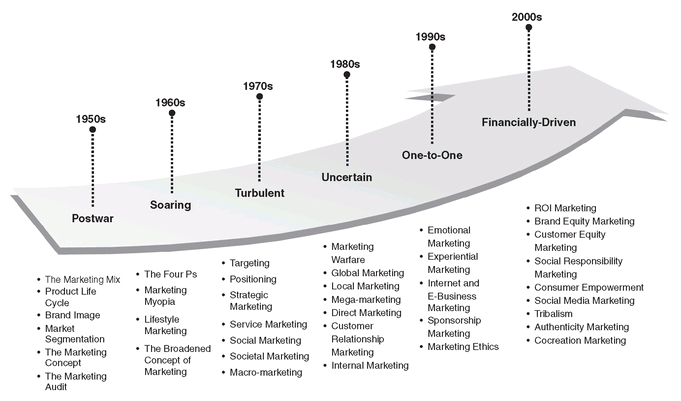
THE FUTURE OF MARKETING: HORIZONTAL NOT VERTICAL
The future of marketing will be partly shaped by current developments and partly by long run forces. In recent years, companies around the world have experienced the deepest recession since the Great Depression of the 1930s. The major fault was overly loose credit extended in the form of mortgages, credit cards, and commercial and residential loans to persons and organizations that could not repay their debts. The culprits were banks, greedy investors, speculators, and junk bond dealers. When the financial bubble burst and housing values nosedived, both the poor and the rich became poorer. Customers cut their spending and shifted their spending to cheaper brands and products. This was disastrous for the U.S. economy where 70 percent of the GDP was made up of consumer spending. Companies laid off many of their workers and unemployment rose from 5 to 10 percent.
The new Obama administration immediately arranged for billions of stimulus dollars to help prop up the economy. It wanted to avoid more corporate implosions like the ones that destroyed Bears Stearns and Lehman Brothers and nearly wiped out AIG, General Motors, and others. The stimulus came just in time and stabilized the situation in mid-2009 without promising much of a recovery; at best, it promised a very slow recovery.
The question is whether consumers in the new decade beginning in 2010 will spend more cautiously than they did in the past. The preceding lifestyle of “buy now, pay later” is less likely to reoccur, partly because of government plans to regulate credit more tightly and partly because of consumer fears and risk aversion. Consumers may want to save more for another rainy day. If spending remains low, then economic growth will be slow, each reinforcing the other. This means that marketers will have to work harder than ever to separate consumers from their dollars.
Marketing 1.0 and 2.0 will still have some relevance. Marketing is still about developing segmentation, choosing the target segment, defining the positioning, providing the four Ps, and building brand around the product. However, the changes in the business environment—recession, climate concerns, new social media, consumer empowerment, new wave technology, and globalization—will continue to create a massive shift in marketing practices.
New marketing concepts always emerge as a reaction to the changing business environment. A recent McKinsey & Company research report lists 10 trends in business following the financial crisis of 2007-2009.3 One major trend reveals that the market in which businesses operate is increasingly turning into a low-trust environment. The Chicago Booth/Kellogg School Financial Trust Index shows that most Americans have the least trust toward large corporations in which they can invest their money. The vertical distrust goes both ways. Financial institutions have also stopped giving credit to consumers.
Today, trust exists more in horizontal relationships than in vertical relationships. Consumers believe one another more than they believe in companies. The rise of social media is simply a reflection of the migration of consumers’ trusts from companies to other consumers. According to Nielsen Global Survey, fewer consumers rely on company-generated advertising.4 Consumers turn to word of mouth as a new and credible form of advertising they can trust. Around 90 percent of consumers surveyed trust recommendations from people they know. Moreover, 70 percent of consumers believe in customer opinions posted online. The research by Trendstream/ Lightspeed Research interestingly shows that consumers trust strangers in their social network more than they trust experts.
All these research findings serve as an early warning for corporations that consumers in general have lost their faith in business practices. Some may argue that this is a business ethics issue and way beyond the reach of marketers. Unfortunately, marketing is partly responsible for this. Marketing is considered the same as selling, using the art of persuasion, and even some manipulation. Even after the birth of modern marketing, which aims to serve consumers, marketing often continues to make exaggerated claims about product performance and differentiation in order to make a sale.
Read the following anecdote about Exxon Mobil a few decades ago—now a company that topped the 2009 Fortune 500 list.
Back in the early 1980s, Exxon Oil Co. held an employee conference to announce its new “core values.” Number one on the list was the simple statement, “The customer comes first.” That evening, division executives discussed the values statement over dinner. One brash young rising star, a fellow named Monty, proposed a toast. “I just want you to know,” he began, “that the customer does not come first.” Monty pointed at the president of the division. “He comes first.” He named the European president. “He comes second.” He named the North American president. “He comes third.” Monty rattled off four more senior executives of the division, all of whom were in the room. “The customer,” he concluded, “comes eighth.” A stunned silence overtook the room before one of the executives smiled, and the gathered group burst out into hysterical laughter. It was the first truth spoken all day.5
It happened a long time ago but we can easily find similar stories today. Many marketers should confess that deep in their hearts consumers are never their top priority. Marketing may be responsible for the decline in consumers’ trust but it also has the biggest chance to solve this issue. After all, marketing is the managerial process that is the closest to the consumers.
We believe it is time to put an end to the marketer-consumer dichotomy. Marketers of any product or service should realize that they are also consumers of other products and services. Consumers should also be aware that they might practice marketing as well in their daily lives to convince their fellow consumers. Everyone is both marketer and consumer. Marketing is not just something marketers do to consumers. Consumers are marketing to other consumers as well.
Table 2.1 The Future of Marketing
| The Disciplines of Marketing | Today’s Marketing Concept | Future Marketing Concept |
|---|---|---|
| Product Management | The Four Ps (product, price, place, promotion) | Cocreation |
| Customer Management | STP (segmentation, targeting, and positioning) | Communitization |
| Brand Management | Brand building | Character building |
We see that marketing concepts over the past 60 years are mostly vertical. To regain the consumers’ trust is to embrace what we call “the new consumer trust system.” The new consumer trust system is horizontal. Consumers today gather in their own communities, cocreate their own products and experiences, and only look outside of their community for admirable characters. They are skeptical because they know that good characters are scarce outside their communities. But once they find one, they will instantly be loyal evangelists.
To succeed, companies should understand that consumers increasingly appreciate cocreation, communitization, and characters (see Table 2.1). Let us examine these three things that we predict will be the three cornerstones of future marketing practices.
Cocreation
Cocreation is a term coined by C.K. Prahalad that describes the new approach to innovation. Prahalad and Krishnan in The New Age of Innovation observed the new ways of creating product and experience through collaboration by companies, consumers, suppliers, and channel partners interconnected in a network of innovation.6 A product experience is never a product experience by itself. It is the accumulation of individual consumer experiences that creates the most value for the product. When individual consumers experience the product, they personalize the experience according to their own unique needs and wants.
We observe three key processes of cocreation. First, companies should create what we call a “platform,” which is a generic product that can be customized further. Secondly, let individual consumers within a network customize the platform to match their own unique identities. Finally, ask for consumer feedback and enrich the platform by incorporating all the customization efforts made by the network of consumers. This practice is common in the open source approach of software development and we believe its application can be stretched to other industries as well. This is how companies should take advantage of the cocreation happening in the consumers’ horizontal network.
Communitization
Technology not only connects and propels countries and companies toward globalization but also connects and propels consumers toward communitization. The concept of communitization is closely related to the concept of tribalism in marketing. In Tribes, Seth Godin argued that consumers want to be connected to other consumers not to companies.7 Companies that want to embrace this new trend should accommodate this need and help consumers connect to one another in communities. Godin argued that succeeding in business requires the support of communities.
According to Fournier and Lee, consumers can organize into communities of pools, webs, or hubs.8 Consumers in pools share the same values although they do not necessarily interact with one another. The only thing keeping them together is their belief and strong affiliation to a brand. This type of community is a typical group of brand enthusiasts that many companies should nurture. Consumers in webs, on the other hand, interact with one another. This is a typical social media community where the bond is rooted in one-to-one relationships among the members. Consumers in hubs are different. They gravitate around a strong figure and create a loyal fan base. The classification of community is consistent with Godin’s argument that consumers are either connected to one another (webs), to a leader (hubs), or to an idea (pools). Godin, Fournier, and Lee all agree that communities exist not to serve the business but to service the members. Companies should be aware of this and participate in serving the members of the communities.
Character Building
For brands to be able to connect with human beings, brands need to develop an authentic DNA that is the core of their true differentiation. This DNA will reflect the brand’s identity in consumers’ social networks. Brands with unique DNAs will have their characters built up throughout their lives. Achieving differentiation is already hard for marketers. Achieving authentic differentiation is even harder.
In their new book, Authenticity,9 Pine and Gilmore argue that when today’s consumers view a brand, they can and will immediately judge whether it is fake or real. Companies should always try to be real and deliver experiences that live up to what they claim. They should not try to only appear real in the advertising or they will instantly lose credibility. In the horizontal world of consumers, losing credibility means losing the whole network of potential buyers.
SHIFT TO HUMAN SPIRIT: THE 3i MODEL
In Marketing 3.0, companies need to address consumers as whole human beings. According to Stephen Covey, a whole human has four basic components: a physical body, a mind capable of independent thought and analysis, a heart that can feel emotion, and a spirit—your soul or philosophical center.10
In marketing, the concept of being relevant to the consumer’s mind began with Al Ries and Jack Trout’s classic book Positioning. 11 They argued that the idea of the product must be positioned meaningfully and uniquely in the mind of the target customers. Thus, the marketers of the Volvo automobile were extremely successful in planting the idea in the mind of automobile buyers that Volvo offered the most safety of any car.
But later, we began to recognize that the emotional component of the human psyche was being neglected. Targeting the mind is no longer enough. Marketers should also target the hearts of consumers. The concept of emotional marketing has been described in several books such as Experiential Marketing by Bernd Schmitt, Emotional Branding by Marc Gobé, and Lovemarks by Kevin Roberts, to name a few.12
Great examples of emotional marketing were achieved by marketers such as Howard Schultz of Starbucks, Richard Branson of Virgin, and Steve Jobs of Apple. Starbucks’ concept of “third place for drinking coffee,” Virgin’s “unconventional marketing,” and Apple’s “creative imagination” are the implementations of emotionally relevant marketing. These efforts were aimed at our emotional hearts, which bear our feelings.
Marketing will need to evolve to a third stage where it addresses the spirit of the consumers. Marketers should try to understand the anxieties and desires of the consumers and do what Stephen Covey calls “unlock the soul’s code” in order to stay relevant. Companies should target consumers as whole human beings who consist of minds, hearts, and spirits. The point is not to overlook the spirit.
In 3.0, marketing should be redefined as a consonant triangle of brand, positioning, and differentiation. 13 To complete the triangle, we introduce the 3i: brand identity, brand integrity, and brand image. In the horizontal world of consumers, brand is useless if it only articulates its positioning. The brand may have a clear identity in consumers’ minds but not necessarily a good one. Positioning is a mere claim that alerts consumers to be cautious of an inauthentic brand. In other words, the triangle is not complete without the differentiation. Differentiation is the brand’s DNA that reflects the true integrity of the brand. It is a solid proof that a brand is delivering what it promises. It is essentially about delivering the promised performance and satisfaction to your customers. Differentiation that is synergetic to the positioning will automatically create a good brand image. Only a complete triangle is a credible one in Marketing 3.0 (see Figure 2.2).
Figure 2.2 The 3i Model

Brand identity is about positioning your brand in the minds of the consumers. The positioning should be unique for your brand to be heard and noticed in the cluttered marketplace. It should also be relevant to the rational needs and wants of the consumers. On the other hand, brand integrity is about fulfilling what is claimed through the positioning and differentiation of the brand. It is about being credible, fulfilling your promise, and establishing consumers’ trust in your brand. The target of brand integrity is the spirit of the consumers. Finally, brand image is about acquiring a strong share of the consumer’s emotions. Your brand value should appeal to consumers’ emotional needs and wants beyond product functionalities and features. You can see that the triangle is intended to be relevant to whole human beings with minds, hearts, and spirits.
Another essential takeaway from this model is that in Marketing 3.0, marketers should target consumers’ minds and spirits simultaneously to touch their hearts. Positioning will trigger the mind to consider a buying decision. A brand requires an authentic differentiation for the human spirit to confirm the decision. Finally, the heart will lead a consumer to act and make the buying decision.
For example, S.C. Johnson & Son, Inc., positioned itself as “the sustainable five-generation family company that specializes in home care consumer products.” The differentiation lies in the sustainable business model. The term “bottom of the pyramid”—referring to people earning less than $1 a day—has been very popular since C.K. Prahalad wrote Fortune at the Bottom of the Pyramid, a book about serving the poor as a profitable and sustainable business.14 However, it was S.C. Johnson & Son that pioneered the practice of serving the bottom of the pyramid in various markets such as Kenya. For the last few years, S.C. Johnson & Son has been a key partner in the development of the bottom of the pyramid protocol with Stuart L. Hart, author of Capitalism at the Crossroads. Therefore, the corporate brand has the integrity to be positioned as the sustainable five-generation family company (see Figure 2.3).
Timberland is another good example of a company with a solid brand integrity. It is positioned as “the good outdoor-inspired footwear and apparel company” (Figure 2.4). The company supports its positioning with a solid differentiation. It is well-known for its “Path of Service,” the community volunteer service program that involves employees of Timberland. The differentiation is already proven since it stands the test of time. In 1994, the company’s net profits fell from $22.5 million to $17.7 million. The following year, sales stayed stagnant, and the company posted an earnings loss for the very first time. Many people predicted that the Path of Service program would be eliminated under such circumstances. But Timberland’s leaders believed that community volunteer service is an integral part of the corporate DNA that makes the brand different and authentic. Therefore, the program continues to this day.15
Figure 2.3 The 3i of S.C. Johnson
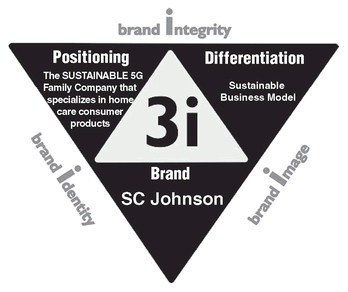
Figure 2.4 The 3i of Timberland
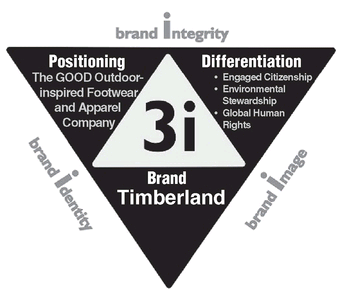
The 3i model is also very relevant for marketing in the context of social media. In the era of consumer empowerment led by abundant information and networked communities, a consonant brand-positioning-differentiation is all you need. There is no chance for inauthentic brands to survive when word-of-mouth becomes the new advertising medium and consumers believe strangers within their community more than they believe companies. Lies and hoaxes exist in social media but they will be exposed quickly by the collective wisdom of the community of consumers.
In social media, a brand is like a member. The brand identity (that is, your avatar) is rated by accumulation of experience within the community. One bad experience will spoil your brand integrity and destroy your brand image in the community. Every social media user knows this. Social media elites guard their characters relentlessly. Marketers should beware of and embrace this trend. Do not enforce too much control over the community of consumers and let them do the marketing for you. Just be true to your brand DNA. Marketing 3.0 is the era of horizontal communication where vertical control will not work. Only honesty, originality, and authenticity will.
SHIFT TO VALUES-DRIVEN MARKETING
Marketers need to identify the anxieties and desires of the consumers to be able to target their minds, hearts, and spirits. In the globalization paradox, the generic anxiety and desire of the consumers is to make their society—and the world at large—a better, perhaps even an ideal place to live. Therefore, companies that intend to be icons should share the same dream with consumers and make a difference.
Some companies are making a difference by means of corporate philanthropy for a social or environmental cause. According to the book Compassionate Capitalism, corporate philanthropy is a great way for companies to start building a good business.16 First, it makes the corporate leaders passionate about a social cause and therefore encourages them to donate personal and/or corporate money to it. Second, the company starts to realize that corporate philanthropy has marketing value. However, these two starting points very often fail. Companies that take the first approach usually fail to incorporate philanthropy as part of the corporate DNA. The ones that take the second approach usually have difficulty in maintaining commitment. Many companies would have difficulty justifying what Timberland did when it maintained the volunteer program during tough times. Moreover, companies can fall into a trap of being inauthentic—doing good activities just to make a sale.
Mission, Vision, and Values
To include good deeds in a corporate culture and maintain commitment, the best approach is to embed them into the company’s mission, vision, and values. Corporate leaders need to think about these statements as the corporate DNA. Look at the inspiring story of Fetzer Vineyards under the leadership of Paul Dolan.17 Dolan realized that to make Fetzer Vineyards an admirable company that demonstrates the best practice of sustainability as well as a proud member of the community, the commitment needs to start at the corporate level, so that all employees take it seriously.
The late Peter Drucker also once argued that starting with a mission may be the first lesson business can learn from successful nonprofits.18 Drucker argued that successful businesses do not start their planning with financial returns. They start with the performance of their mission. Financial returns will come as results.
Some people define mission as a statement that expresses the business your company is in. In a dynamic business environment, the definition of business scope can change very fluidly. Therefore, we prefer to define a mission in more enduring terms as your company’s reason for being; it reflects the company’s basic purpose for existence. A company should characterize its mission as fundamentally as possible, as it will determine the sustainability of the company.
Inspired by a famous principle of Charles Handy, we symbolize a company’s mission with a doughnut. 19 The doughnut principle basically says that life is like an inverted doughnut, in which the hole is on the outside and the dough is in the middle. In the doughnut view of life, the core is fixed and the bounded space around the core is flexible. The company’s mission is the core that cannot be changed. The operations and business scope of the company are flexible but should be aligned with the core.
While mission is firmly rooted in the past when the company was established, vision is about inventing the future. Vision can be defined as a picture of the desirable future state of the company. It explains what the company aspires to become and achieve. To define this, a company needs to create a mental picture of the future given the definition of the corporate mission. We symbolize it by a compass that guides a company to its future state.
On the other hand, values can be considered as “a corporation’s institutional standards of behavior.”20 Because companies generally follow the same values cycle, they are symbolized as a wheel. Values articulate a set of corporate priorities and management attempts to embed them in its practices, which it hopes will reinforce behaviors that benefit the company and communities inside and outside the firm, and which in turn strengthen the institution’s values.
In summary, a values-based matrix should also be introduced where, on one axis, the company strives to occupy the minds, hearts, and spirits of current and future customers. The other axis takes into account the company’s mission, vision, and values (Figure 2.5). While delivering performance and satisfaction to the customers at the product level is essential, at the highest level, a brand ought to be seen as realizing emotional aspirations and practicing compassion in some form. It must not only promise ProfitAbility and ReturnAbility to current and future shareholders, but also SustainAbility. It must also become a brand that is better, different, and that makes a difference to current and future employees.
Figure 2.5 Values-Based Matrix (VBM) Model
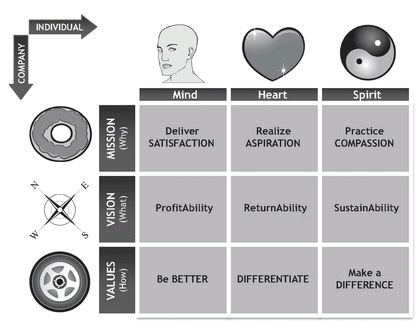
For example, S.C. Johnson & Son embeds its commitment to social and environmental sustainability in the mission, vision, and values of the company (Figure 2.6). With the mission of “contributing to the community well-being as well as sustaining and protecting the environment,” S.C. Johnson & Son satisfies consumers by providing various products, realizes aspirations by inviting customer participation in sustaining the environment, and practices compassion by targeting the base of the pyramid market.
Figure 2.6 Values-Based Matrix of S.C. Johnson
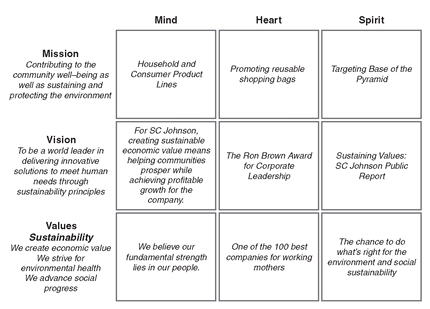
The company has the vision to be the world leader in delivering innovative solutions to meet human needs through sustainable principles. The achievement of the vision is marked by profitable growth and several awards presented to the company. It also releases a public report to share its achievement in the area of sustainability.
The values of S.C. Johnson & Son are rooted in the concept of the triple bottom line: economic value, environmental health, and social progress. To target the minds, hearts, and spirit of current and future employees, the company uses the triple bottom line concept. By saying that the company’s fundamental strength lies in its people, it targets the mind. To target the heart, the company hires mothers and was dubbed one of the 100 best companies for working mothers. By offering the opportunity to do what’s right for the environment and social sustainability, the company targets the spirit.
Figure 2.7 Values-Based Matrix of Timberland

Consider the Timberland example. Timberland has a simple mission of making its products better (Figure 2.7). It delivers customer satisfaction through its quality products and fosters emotional experiences through store design, for example. To target the spirit, it includes the mission as a tagline.
Timberland has the vision to be the twenty-first-century example of a socially responsible corporation around the world. It shows a remarkable achievement for its vision over the past years and can use the achievement to market the company to shareholders. Rationally, the vision is shown by the profit growth the company is enjoying. Emotionally, it is shown by the impressive stock performance. Spiritually, it is shown by the Sustainability Key Performance Indicators.
For its employees, Timberland builds the values of humanity, humility, integrity, and excellence. It demonstrates these values to the employees through various efforts. The most important one is the Path of Service, which provides the opportunity for employees to practice the values.
MARKETING 3.0: THE MEANING OF MARKETING AND THE MARKETING OF MEANING
By closely examining the 3i model you will see the new meaning of marketing in 3.0. Marketing in its culmination will be a consonance of three concepts: identity, integrity, and image. Marketing is about clearly defining your unique identity and strengthening it with authentic integrity to build a strong image.
Marketing 3.0 is also about the marketing of meaning embedded in the corporate mission, vision, and values. By defining marketing in this manner, we wish to elevate the state of marketing further into being a major player in the designing of the company’s strategic future. Marketing should no longer be considered as only selling and using tools to generate demand. Marketing should now be considered as the major hope of a company to restore consumer trust.
NOTES
1 Neil Borden mentioned the term “marketing mix” in 1953 in his American Marketing Association presidential address. The four Ps were later introduced in Jerome McCarthy’s Basic Marketing: A Managerial Approach (1st edition) (Homewood, IL: Irwin, 1960).
2 Public opinion and political power were added by Kotler in 1984; people, process, and physical evidence were added by Boom and Bitner in 1981.
3 Eric Beinhocker, Ian Davis, and Lenny Mendonca, “The Ten Trends You Have to Watch,” Harvard Business Review, July–August 2009.
4 “Personal Recommendations and Consumer Opinions Posted Online Are the Most Trusted Forms of Advertising Globally,” press release (New York: The Nielsen Company, July 7, 2009).
5 Art Kleiner, Who Really Matters: The Core Group Theory of Power, Privilege, and Success (New York: The Doubleday Broadway Publishing Group, 2003).
6 C.K. Prahalad and M.S. Krishnan, The New Age of Innovation: Driving Co-created Value through Global Networks (New York: McGraw-Hill, 2008).
7 Seth Godin, Tribes: We Need You to Lead Us (New York: Portfolio, 2008).
8 Susan Fournier and Lara Lee, “Getting Brand Communities Right,” Harvard Business Review, April 2009.
9 James H. Gilmore and B. Joseph Pine II, Authenticity: What Consumers Really Want (Boston: Harvard Business School Press, 2007).
10 Stephen R. Covey, The 8th Habit: From Effectiveness to Greatness (New York: Free Press, 2004).
11 Al Ries and Jack Trout, Positioning: The Battle for Your Mind (New York: McGraw-Hill, 1981).
12 For further reading, see Bernd H. Schmitt, Experiential Marketing: How to Get Customers to Sense, Think, Act, Relate to Your Company and Brands (New York: Free Press, 1999); Marc Gobé, Emotional Branding: The New Paradigm for Connecting Brands to People (New York: Allworth Press, 2001); Kevin Roberts, Lovemarks: The Future Beyond Brands (New York: Powerhouse Books, 2004).
13 The original Brand-Positioning-Differentiation Triangle can be found in Philip Kotler, Hermawan Kartajaya, Hooi Den Huan, and Sandra Liu, Rethinking Marketing: Sustainable Marketing Enterprise in Asia (Singapore: Pearson Education Asia, 2002).
14 C.K. Prahalad, The Fortune at the Bottom of the Pyramid: Eradicating Poverty through Profits (Philadelphia: Wharton School Publishing, 2005).
15 James Austin, Herman B. Leonard, and James W. Quinn, “Timberland: Commerce and Justice,” Harvard Business School Case, revised December 21, 2004.
16 Marc Benioff and Karen Southwick, Compassionate Capitalism: How Corporations Can Make Doing Good an Integral Part of Doing Well (Franklin Lakes, New Jersey: The Career Press Inc., 2004).
17 Paul Dolan and Thom Elkjer, True to Our Roots: Fermenting a Business Revolution (New York: Bloomberg Press, 2003).
18 Peter F. Drucker, “What Business Can Learn from Nonprofits,” Classic Drucker (Boston: Harvard Business School Press, 2006).
19 Charles Handy, “Finding Sense in Uncertainty” in Rowan Gibson, Rethinking the Future: Rethinking Business, Principles, Competition, Control and Complexity, Leadership, Markets, and the World (London: Nicholas Brealey Publishing, 1997).
20 Reggie Van Lee, Lisa Fabish, and Nancy McGaw, “The Value of Corporate Values,” strategy+business, Issue 39.
..................Content has been hidden....................
You can't read the all page of ebook, please click here login for view all page.
